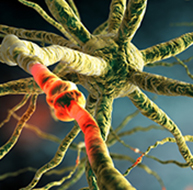Definition
Biofeedback training (BFT) and neurofeedback training (NFT) involve the same learning processes we use to develop motor skills or master a videogame. An individual acts (breathes effortlessly), observes the results (heart rate
variability increases), and repeats this action during meetings with clients. Clients actively learn to regulate their psychophysiology (Thompson & Thompson, 2016). Biofeedback is also a "psychophysiological mirror" that teaches individuals to monitor, understand, and change their physiology (Peper, Shumay, & Moss, 2012). Biofeedback teaches clients to listen to their bodies. Although they initially use equipment to track their physiology, biofeedback training progressively replaces external with internal cues. Graphic by Dani S@unclebelang adapted from Erik Peper.

NFT is a branch of BFT that provides real-time displays using an electroencephalograph (EEG), as opposed to an electromyograph (EMG), heart rate variability (HRV), skin temperature, or other psychophysiological measures. An electroencephalograph monitors brain electrical activity (e.g., brainwaves), while an electromyograph detects muscle action potentials from skeletal muscles. These modalities differ in the signals they detect, process, and display (Collura, 2014).
The Process of Neurofeedback
Neurofeedback is the process of interacting with an electronic device that measures and feeds back information about brain electrical activity.
The goals of this process are to:
(1) ensure correct regulatory function in the brain's neuromodulating systems
(2) encourage global neuropsychophysiological change
(3) correct specific, distinct, identifiable disorders or barriers to optimal performance that result from underlying dysregulation
(4) enhance performance by optimizing nervous system functioning
What Neurofeedback Does
(1) Neurofeedback provides accurate, timely, and helpful information to the client in the form of visual, auditory, or tactile feedback that responds to meaningful changes in monitored neuronal systems
(2) Neurofeedback training promotes flexibility, resilience, and choice
Click on the link to view Neurofeedback Overview, produced by the International Society for Neuroregulation and Research (ISNR). Graphic © ibreakstock/Shutterstock.com.
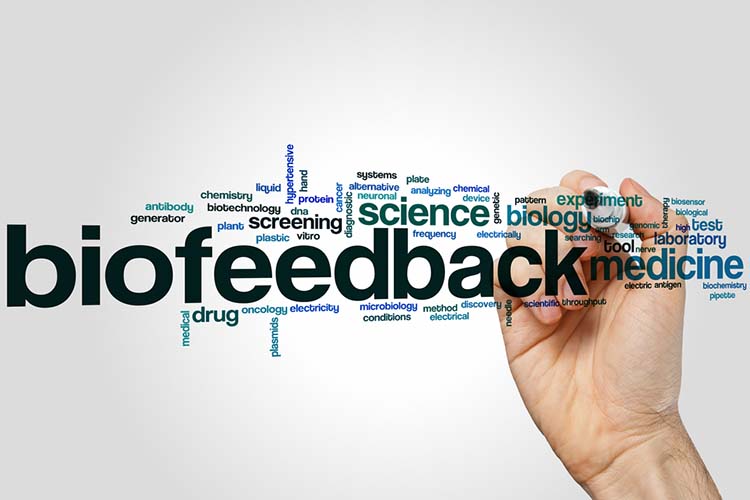
BFT may be more effective when training promotes mindfulness. A mindfulness approach teaches clients to focus on their immediate feelings, cognitions, and sensations in an accepting and non-judgmental way, to distinguish between what can and cannot be changed, and to change the things they can (Khazan, 2013).
Clients can become stuck when they focus on outcomes they cannot immediately control. For example, James, an undergraduate Psychology major, was diagnosed with ADHD. For example, James, an undergraduate Psychology major, was diagnosed with ADHD. When he ruminated about his mistakes on daily quizzes, this undermined his motivation to study and resulted in lower scores. He could not study while he worried about his quiz performance. When James learned to accept occasional mistakes without fear, his studying and course grade improved. James succeeded by changing what he could: his reaction to unavoidable errors. Graphic © Ivelin Radkov/Shutterstock.com

BCIA Blueprint Coverage
This unit addresses I. Orientation to Neurofeedback - A. Definition of Neurofeedback (EEG
Biofeedback).

This unit covers Definitions of Biofeedback and Neurofeedback, Physiological Monitoring and Modulation Are Not Biofeedback, and Quantum Biofeedback and LenyosisTM.
Please click on the podcast icon below to hear a full-length lecture.

Definitions of Biofeedback and Neurofeedback
Since neurofeedback is a specialized application of biofeedback, we will start with the Biofeedback Alliance and Nomenclature Task Force definition (Schwartz, 2010).
Biofeedback Alliance and Nomenclature Task Force (2008)
Biofeedback is a process that enables an individual to learn how to change physiological activity for the purposes of improving health and performance. Precise instruments measure physiological activity such as brainwaves, heart function, breathing, muscle activity, and skin temperature. These instruments rapidly and accurately 'feed back' information to the user. The presentation of this information — often in conjunction with changes in thinking, emotions, and behavior — supports desired physiological changes. Over time, these changes can endure without continued use of an instrument.The main elements of this definition are that (1) biofeedback is a learning process that teaches an individual to control her physiological activity, (2) biofeedback training aims to improve health and performance, (3) instruments rapidly monitor an individual's performance and display it back to her, (4) the individual uses this feedback to produce physiological changes, (5) changes in thinking, emotions, and behavior often accompany and reinforce physiological changes, and (6) these changes become independent of external feedback from instruments. Graphic © rumruay/Shutterstock.com.
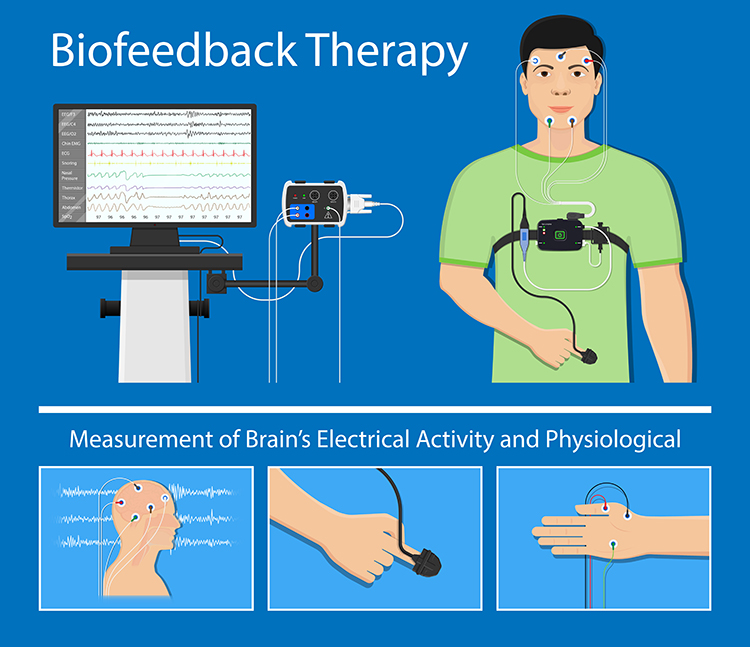
The Biofeedback Certification International Alliance (BCIA) emphasized that neurofeedback is a form of biofeedback in its Blueprint of Knowledge.
Biofeedback Certification International Alliance (2016) definition of neurofeedback
Neurofeedback is employed to modify the electrical activity of the CNS, including EEG, event-related potentials, slow cortical potentials and other electrical activity either of subcortical or cortical origin. Neurofeedback is a specialized application of biofeedback of brainwave data in an operant conditioning paradigm. The method is used to treat clinical conditions as well as to enhance performance.
The International Society for Neurofeedback and Research (ISNR) provided a comprehensive definition of neurofeedback that described the similarities and differences between neurofeedback and biofeedback.
International Society for Neurofeedback and Research (2010) definition of neurofeedback
Like other forms of biofeedback, NFT uses monitoring devices to provide moment-to-moment information to an individual on the state of their physiological functioning. The characteristic that distinguishes NFT from other biofeedback is a focus on the central nervous system and the brain. Neurofeedback training (NFT) has its foundations in basic and applied neuroscience as well as data-based clinical practice. It takes into account behavioral, cognitive, and subjective aspects as well as brain activity.This definition was ratified by the ISNR Board of Directors on January 10, 2009, and edited on June 11, 2010. It emphasizes that neurofeedback is a "self-regulation method" that teaches clients to voluntarily change central nervous system activity. It draws a sharp distinction between neurofeedback and neuromodulatory approaches like audio-visual entrainment (AVE) and rTMS that alter the brain by exposing it to a stimulus. While these are potentially valuable adjunctive procedures, they do not provide feedback of brain activity nor teach self-regulation.
NFT is preceded by an objective assessment of brain activity and psychological status. During training, sensors are placed on the scalp and then connected to sensitive electronics and computer software that detect, amplify, and record specific brain activity. Resulting information is fed back to the trainee virtually instantaneously with the conceptual understanding that changes in the feedback signal indicate whether or not the trainee's brain activity is within the designated range. Based on this feedback, various principles of learning and practitioner guidance, changes in brain patterns occur and are associated with positive changes in physical, emotional, and cognitive states. Often the trainee is not consciously aware of the mechanisms by which such changes are accomplished although people routinely acquire a 'felt sense' of these positive changes and often are able to access these states outside the feedback session.
NFT does not involve either surgery or medication and is neither painful nor embarrassing. When provided by a licensed professional with appropriate training, generally trainees do not experience negative side-effects. Typically trainees find NFT to be an interesting experience. Neurofeedback operates at a brain functional level and transcends the need to classify using existing diagnostic categories. It modulates the brain activity at the level of the neuronal dynamics of excitation and inhibition which underlie the characteristic effects that are reported.
Research demonstrates that neurofeedback is an effective intervention for ADHD and Epilepsy. Ongoing research is investigating the effectiveness of neurofeedback for other disorders such as Autism, headaches, insomnia, anxiety, substance abuse, TBI and other pain disorders, and is promising.
Being a self-regulation method, NFT differs from other accepted research-consistent neuro-modulatory approaches such as audio-visual entrainment (AVE) and repetitive transcranial magnetic stimulation (rTMS) that provoke an automatic brain response by presenting a specific signal. Nor is NFT based on deliberate changes in breathing patterns such as respiratory sinus arrhythmia (RSA) that can result in changes in brain waves. At a neuronal level, NFT teaches the brain to modulate excitatory and inhibitory patterns of specific neuronal assemblies and pathways based upon the details of the sensor placement and the feedback algorithms used, thereby increasing flexibility and self-regulation of relaxation and activation patterns.
Perspective
Two issues that require clarification are the focus of biofeedback and NFT and the possibility or likelihood of negative side effects.First, the ISNR definition states: "The characteristic that distinguishes NFT from other biofeedback is a focus on the central nervous system and the brain." This description supports the view that while NFT is top-down, biofeedback training (BFT) is bottom-up. A more nuanced explanation is that both NFT and BFT involve top-down and bottom-up interventions. The arbitrary differentiation between body-centered and central nervous system (CNS) interventions results from an incomplete understanding of the interconnections between these systems. For example, the CNS is instrumental in modifying behaviors like respiration, and changes in respiration modulate CNS activity. Hyperventilation leading to hypocapnia causes a general slowing of the EEG (Takahashi, 2005).
Therefore, NFT and BFT share components like breathing, education about the training process, mindfulness, and problem-solving, involving the "central nervous system and the brain." Likewise, since the central and peripheral nervous systems cooperate through complex feedback and feedforward loops, we can conceptualize them as one complex integrated system.

For example, clinicians who treat ADHD may begin treatment with heart rate variability biofeedback (HRVB), which trains clients to increase the difference in the time intervals between successive heartbeats. Whereas attention involves brainstem, subcortical, and cortical networks, successful HRVB training (which is often characterized as bottom-up) may significantly increase continuous attention and make NFT unnecessary or may facilitate improved outcomes when followed by NFT for this condition.
Second, the ISNR definition claims: "When provided by a licensed professional with appropriate training, generally trainees do not experience negative side-effects."Hammond and Kirk (2008) marshaled evidence from randomized controlled trials (RCTs) and anecdotal reports that when applied incorrectly, neurofeedback can be associated with adverse reactions like anxiety, depression, emotional lability, explosiveness, incontinence, OCD, and sedation.
Hammond and Kirk did not rigorously evaluate the anecdotal reports supplied by clinicians for length or severity of disruption resulting from NFT. In most cases, such effects are temporary unless reinforced by continuing incorrect training approaches (J. S. Anderson, personal communication, June 6, 2016).
Rogel et al. (2015) reported that a randomized, sham-controlled, double-blind study found no statistically significant differences in the number of side effects reported between sham and upper alpha and SMR treatment groups. The SMR group had a higher number of reported headaches.
Core Elements of Neurofeedback
The client-practitioner relationship is the foundation of BFT and NFT. Neurofeedback is most effective when clients and providers are mindful because this promotes self-awareness and a sense of agency. Neurofeedback promotes self-regulation when a practitioner provides effective coaching (Khazan, 2019).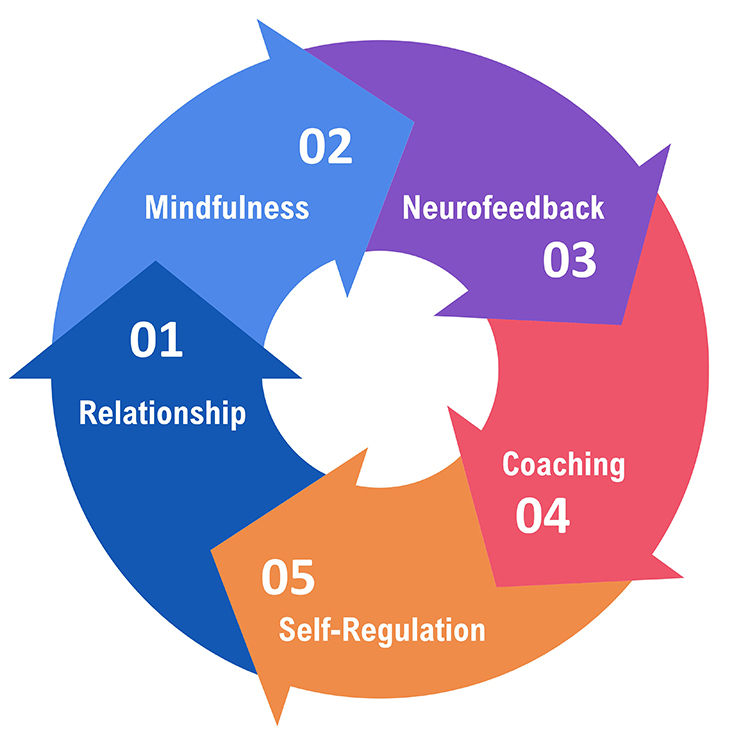
Inter-Brain Synchrony
Therapy provides a structured environment where patients can repeatedly experience and strengthen inter-brain synchrony (Meehan, 2025; Sened et al., 2022). In inter-brain synchrony, the neural activity of two individuals becomes aligned during social interactions. This synchrony is observed in therapeutic settings when a therapist and a patient engage in shared emotional and cognitive processes, such as maintaining eye contact, mirroring expressions, and synchronizing speech rhythms.This mutual alignment of brain activity, often termed neural coupling, facilitates a deeper interpersonal connection and effective communication Over time, this repeated neural coupling can lead to lasting neurobiological adaptations, reinforcing healthier emotional and cognitive frameworks. Vagus nerve graphic © Axel_Kock/Shutterstock.com.
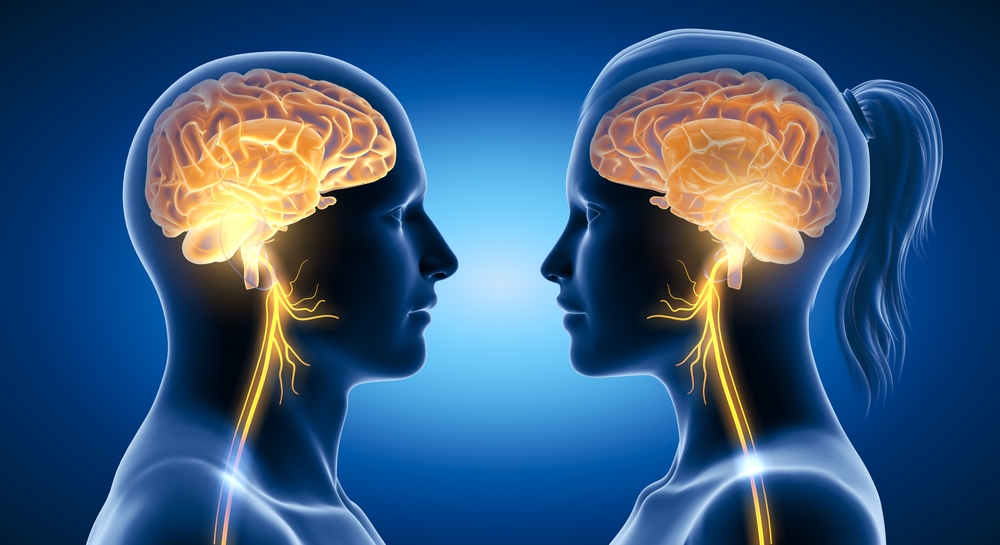
Further evidence suggests that synchrony strengthens emotional bonds and improves cognitive flexibility. When neural coupling occurs, it facilitates better communication between brain regions associated with decision-making, problem-solving, and emotional processing. This may explain why clients who engage in therapy with high levels of synchrony often experience deeper insights, improved emotional resilience, and greater capacity for behavioral change. Understanding and intentionally fostering this synchrony can, therefore, be a powerful tool in therapeutic practice, enhancing the overall efficacy of interventions.
For therapists, these findings underscore the importance of fostering therapeutic synchrony as an active component of treatment. Beyond verbal communication, nonverbal cues such as body language, tone of voice, and paced responsiveness contribute significantly to inter-brain synchrony. Therapists who practice mindfulness, attunement, and embodied presence may enhance their ability to facilitate neural synchrony with clients, potentially amplifying the effectiveness of therapy.
Moreover, this perspective encourages therapists to view relational healing not only as a psychological process but also as a neurobiological one. Clients who struggle with attachment issues, social difficulties, or trauma may particularly benefit from interventions that emphasize relational presence, attunement, and co-regulation.
Relational presence refers to the therapist’s capacity to fully engage with the client, establishing an environment of genuine connection and trust where the client feels seen and valued. Attunement is the process by which the therapist accurately perceives and sensitively responds to the client’s emotional signals, thereby fostering a therapeutic interaction that validates the client’s internal experience. Co-regulation involves a collaborative dynamic in which the therapist supports the client in managing and modulating their emotional states, ultimately aiding the client in developing effective self-regulation skills. Collectively, these processes help create a secure relational framework essential for healing and developing adaptive emotional responses.
Physiological Monitoring and Modulation Are Not Biofeedback
Physiological monitoring, detecting biological activity like blood pressure, is only one biofeedback component. When nurses measure your blood pressure, this is physiological monitoring. Nurses provide biofeedback when they report these values to you because this gives you information about your biological performance. When your nurse announces that your blood pressure was 120/70, this closes the loop and allows you to refine your self-awareness and control of your physiology. Graphic © Sean Locke Photography/Shutterstock.com.

Listen to a mini-lecture on Physiological Monitoring and Modulation © BioSource Software LLC.
Likewise, modulation, stimulating the nervous system to produce psychophysiological change, is not biofeedback because it acts on your body instead of providing you with information about its performance.
For example, a physical therapist might treat back pain through a modality called muscle stimulation. A current delivered to postural muscles fatigues them so that they cannot produce painful spasms. After muscle stimulation brings spasms under control, a physical therapist can initiate surface electromyographic (SEMG) biofeedback to teach the patient to increase awareness and control of postural muscle contraction. Graphic © DreamBig/Shutterstock.com.
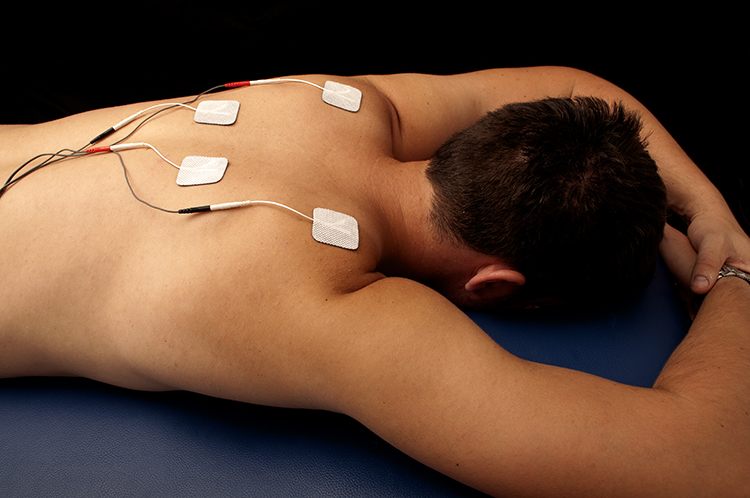
Similarly, various devices that input signals into the central nervous system are not biofeedback devices but are generally known as entrainment devices. These include Audio-Visual Entrainment (AVE), Cranial Electrotherapy Stimulation (CES), repetitive Transcranial Magnetic Stimulation (rTMS), repetitive Transcranial Direct Current Stimulation (rTDCS), pulsed ElectroMagnetic Frequency Stimulation (pEMF), and others. These interventions may be useful and may provide an effective adjunct to biofeedback. However, since they do not provide information directly to the individual in a learning paradigm, they are not biofeedback. They represent treatment, not training. For this reason, providers should confirm that the use of these modalities falls within their scope of practice. The David Delight Pro, an AVE device, is shown below.
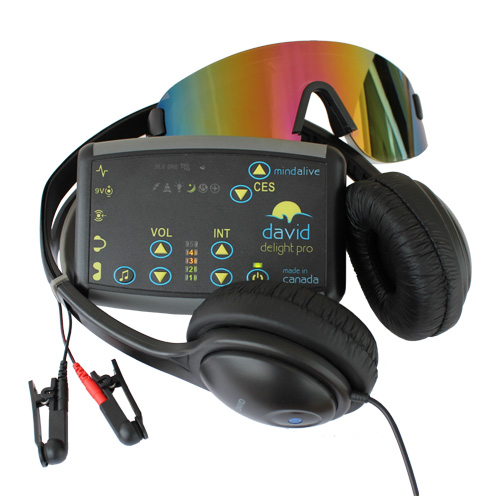
Quantum Biofeedback and LenyosisTM
Slawecki (2009) cautioned consumers in "How to Distinguish Legitimate Biofeedback/Neurofeedback Devices."
The Sept. 3, 2009 Seattle Times published an exposé on pseudo-biofeedback devices: "Miracle Machines: The 21st-Century Snake Oil."

Appending biofeedback to a product's name does not make it biofeedback. Exposing clients to electromagnetic fields is modulation. Since biofeedback provides clients with real-time performance information to guide self-regulation, Quantum Biofeedback and LenyosysTM devices fall outside this definition.
Quantum Biofeedback
Quantum Biofeedback (EPFX / SCIO / XRROID / QXCI) devices do not provide individuals with immediate information regarding their performance. Marketers advertise that these instruments monitor, diagnose, and correct cellular abnormalities at a quantum level without providing peer-reviewed data. Critics claim that treatment with these devices may result in false diagnoses and delay effective treatment for medical disorders.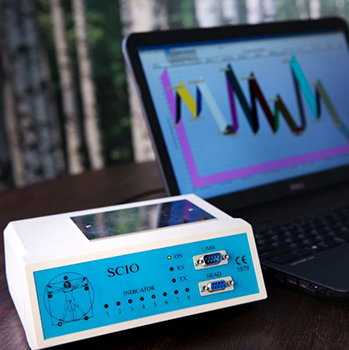
The following information was retrieved from the Empowering Change in You site on December 27, 2009. Note the disclaimer about "curing" medical conditions and explanation that it produces changes through stress management:
The function of the Quantum Biofeedback/EPFX is similar to a virus-scan on a computer. It focuses on your energetic body, which offers a more complete view of each facet of your health. Based on Quantum Physics, it runs a comprehensive test that measures the body’s frequencies. The system then contributes frequencies designed to resonate within the body, thus creating balance.
The human body is composed of a biochemical structure and an electromagnetic field. It performs best when these functions are balanced with one another and in complete harmony. Unfortunately, the daily stresses of life that confront each and every one of us takes its toll on the human body. Stress reduction is essential for wellness. This energy work is non-invasive.
It is important to remember that energetic medicine does not "cure" health problems. It addresses them specifically by making energetic corrections and rebalancing the system through stress management.
LenyosysTM
LenyosysTM describes its pulsed electromagnetic technology as a "body-biofeedback modality":Ideal as a complement to neurofeedback and biofeedback therapy, BRT is a body-biofeedback modality that helps to address the physical and somatic symptoms of both simple and complex health issues including digestive problems, systemic inflammation, muscle and joint aches, drug and alcohol addiction, allergies and hypersensitivities, stress, trauma and chronic illness. Whether used before, right after or in between sessions, BRT works in tandem with neurofeedback and biofeedback to create synergies that relax the client, enhance the therapy session and improve end results.

Pulsed electromagnetic treatment is modulation--not biofeedback. Instead of providing double-blind studies of their product's effectiveness, the marketers provide references for the application of Pulsed Electromagnetic Field Therapy (PEMF) and magnetism for specific applications.
This Real Genius episode was drawn by Dani S on Fiverr.com.

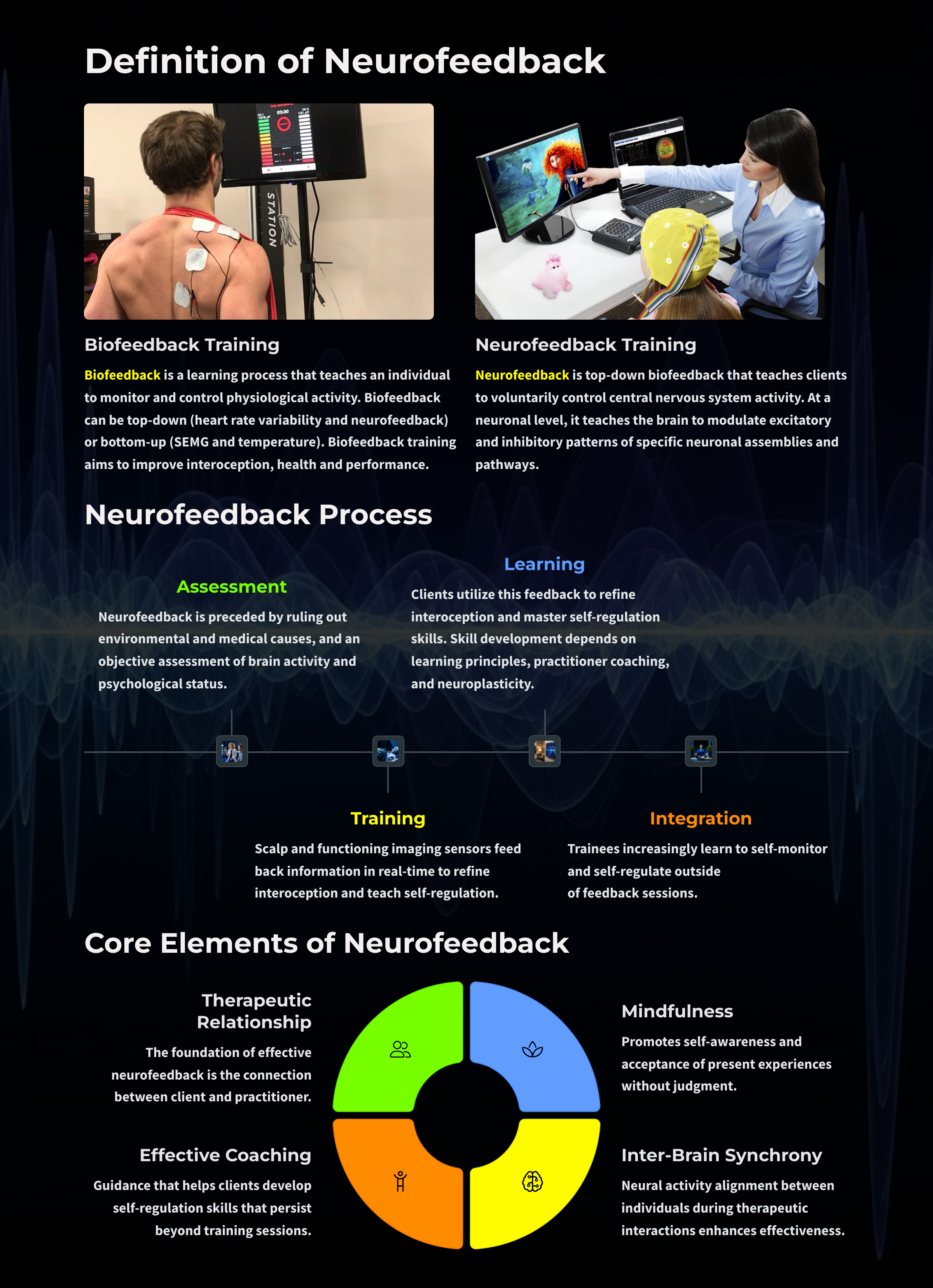
Glossary
adverse reactions: iatrogenic effects like anxiety and sedation associated with BFT and NFT.
attunement: the process by which a therapist accurately perceives and responds to a clients emotional state.
biofeedback: (1) learning process that teaches an individual to control her physiological activity, (2) the aim of biofeedback training is to improve health and performance, (3) instruments rapidly monitor an individual's performance and display it back to her, (4) the individual uses this feedback to produce physiological changes, (5) changes in thinking, emotions, and behavior often accompany and reinforce physiological changes, and (6) these changes become independent of external feedback from instruments. Information about psychophysiological performance is obtained by noninvasive monitoring and used to help individuals achieve self-regulation through a learning process that resembles motor skill learning.
bottom-up interventions: training that directly targets peripheral nervous system networks.
central nervous system: the division of the nervous system that includes the brain, spinal cord, and retina.
classical conditioning: unconscious associative learning process that modifies reflexive behavior and prepares us to respond to future situations rapidly.
co-regulation: the process through which one person helps another regulate their emotional state through interaction and connection.
electroencephalograph: an instrument that measures brain electrical activity.
electromyograph: an instrument that measures skeletal muscle action potentials.
entrainment devices: instruments that input signals such as light, sound, or electricity into the central nervous system.
feedback: in cybernetic theory, orders to act to correct small errors to prevent larger future errors in a closed system.
feedforward: in cybernetic theory, orders to perform an action based on anticipated conditions in an open system.
heart rate variability biofeedback: the display of beat-to-beat changes in heart rate that include changes in the RR intervals between consecutive heartbeats.
homeostasis: a state of dynamic constancy achieved by stabilizing conditions about a setpoint, whose value may change over time, proposed by Bernard and Cannon.
inter-brain plasticity: the capacity of the brain to adapt and change based on repeated neural synchrony with another person.
mindfulness: accepting and non-judgmental focus of attention on the present on a moment-to-moment basis.
modulation: stimulating the nervous system to produce psychophysiological change.
neural coupling: the synchronization of brain activity between two individuals during social or therapeutic interactions.
neurofeedback: information about EEG activity obtained by noninvasive monitoring and used to help individuals achieve self-regulation through a learning process that resembles motor skill learning.
operant conditioning: an unconscious associative learning process that modifies the form and occurrence of voluntary behavior by manipulating its consequences.
peripheral nervous system: nervous system subdivision that includes autonomic and somatic branches.
physiological monitoring: measurement of biological activity like EEG activity.
relational presence: a therapist's ability to be fully engaged and attuned to a client in a way that fosters connection and trust.
self-regulation: control of your behavior (e.g., voluntary increase in low-beta amplitude).
therapeutic synchrony: the alignment of emotional and cognitive processes between therapist and client that enhances the therapeutic process.
top-down interventions: training that directly targets central nervous system frontal, parietal, and limbic networks.
TEST YOURSELF ON CLASSMARKER
Click on the ClassMarker logo below to take a 10-question exam over this entire unit. There is no password.

REVIEW FLASHCARDS ON QUIZLET
Click on the Quizlet logo to review our chapter flashcards.

Visit the BioSource Software Website
BioSource Software offers Physiological Psychology which satisfies BCIA's Physiological Psychology requirement, and Neurofeedback100, which provides extensive multiple-choice testing over the Biofeedback Blueprint.

Assignment
Now that you have completed this unit, how would you explain neurofeedback to a client? How would you explain the relationship between biofeedback and neurofeedback training?
References
Biofeedback Certification International Alliance (2016). Blueprint of knowledge statements for board certification in neurofeedback. Retrieved from http://www.bcia.org/files/public/EEGBlueprint.pdf
Collura, T. F. (2014). Technical foundations of neurofeedback. Routledge.
Hammond, D. C., & Kirk, L. (2008). First, do not harm: Adverse effects and the need for practice standards in neurofeedback. Journal of Neurotherapy, 12(1), 79-88. https://doi.org/10.1080/10874200802219947
International Society for Neurofeedback and Research (2016). Definition of neurofeedback. Retrieved from http://www.isnr.org/#!neurofeedback-introduction/c18d9
Khazan, I. (2013). The clinical handbook of biofeedback: A step-by-step guide for training and practice with mindfulness. John Wiley & Sons, Ltd.
Khazan, I. (2019). Biofeedback and mindfulness in everyday life: Practical solutions for improving your health and performance. W. W. Norton & Company.
Meehan, Z. M. (2025). 5-min science: Inter-brain plasticity can enhance psychotherapy. https://www.biosourcesoftware.com/post/5-min-science-inter-brain-plasticity-can-enhance-psychotherapy
Rogel, A., Guez, J., Getter, N., Keha, E., Cohen, T., Amor, T., & Todder, D. (2015). Transient adverse side effects during neurofeedback training: A randomized, sham-controlled, double blind study. Applied Psychophysiology and Biofeedback, 40(3), 209-218. https://doi.org/10.1007/s10484-015-9289-6
Schwartz, M. S. (2010). A new improved universally accepted official definition of biofeedback: Where did it come from? Why? Who did it? Who is it for? What's next? Biofeedback, 24, 88-90. https://doi.org/10.5298/1081-5937-38.3.88
Sened, H., Zilcha-Mano, S., & Shamay-Tsoory, S. (2022). Inter-brain plasticity as a biological mechanism of change in psychotherapy: A review and integrative model. Frontiers in Human Neuroscience, 16, 955238. https://doi.org/10.3389/fnhum.2022.955238
Takahashi, T. (2005). Activation methods. In E. Niedermeyer & F. Lopes da Silva (Eds.). Electroencephalography: Basic principles, clinical applications, and related fields (5th ed.). Lippincott, Williams & Wilkins.
Thompson, M., & Thompson, L. (2016). The neurofeedback book: An introduction to basic concepts in applied psychophysiology (2nd ed.). Association for Applied Psychophysiology and Biofeedback.
